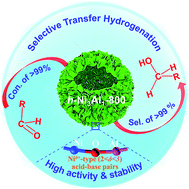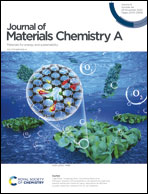Layered double hydroxide derived NiAl-oxide hollow nanospheres for selective transfer hydrogenation with improved stability†
Abstract
Selective transfer hydrogenation (STH) is an efficient strategy in biomass upgradation, especially for the production of unsaturated alcohols from biomass-derived α,β-unsaturated aldehydes. Design of effective catalysts with excellent stability for the STH is highly desired. Here, we report the synthesis of Ni3Al1-oxide hollow nanospheres (h-Ni3Al1-800) derived from Ni3Al1 layered double hydroxide grafted on hollow polymer spheres (HPS@Ni3Al1-LDH) by calcination at 800 °C in air. h-Ni3Al1-800 is an efficient catalyst for the STH of α,β-unsaturated aldehydes with selectivities towards α,β-unsaturated alcohols >99% at almost full conversions. More importantly, h-Ni3Al1-800 can be recycled at least 12 times without loss of activity. Experimental results and DFT calculations prove that the Al dopant in h-Ni3Al1-800 provides much stable Niδ+-type (2 < δ < 3) acid–base pairs which can efficiently catalyze the STH with improved stability. This work provides a promising direction for the design of STH catalysts that have potential for industrial applications.



 Please wait while we load your content...
Please wait while we load your content...